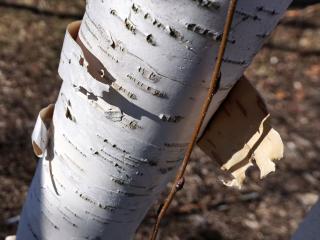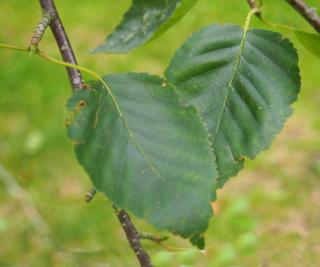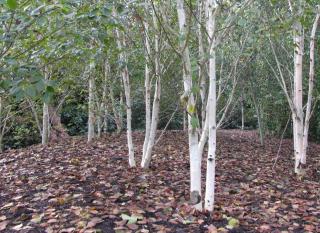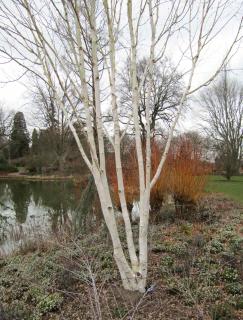

In the birch family, Betula utilis jacquemontii shines with its silver-white trunk.
Betula utilis jacquemontii key facts
Name: Betula utilis jacquemontii
Family – Betulaceae
Type – tree
Foliage – deciduous
Height – 32 to 36 feet (10 to 12 meters)
Width – 20 to 25 feet (7 to 8 m)
Exposure – Sun to part sun
Soil – any type but chalky, well drained
Hardiness: hardy – Growth: fast when not in limestone – Flowering: spring

Also of interest is the foliage: it matures into a darker green hue than that of other birches. In fall, the ovate leaves slowly take on a magnificent yellow color.
As for the flowering, jacquemontii is covered in many catkins at the beginning of spring. Male ones are yellow-brown, and up to 5 inches long (12 cm). Female ones are shaped like green panicles forming near-perfect cylinders. Fruits, when they form, are about 2 inches long (5 cm). These are short cone-shaped tubes. The scales open up one after the other to release little, winged seeds.
Did you know ? Betula utilis earned that name because it has many uses: from paper pulp to umbrellas, shingles on rooftops… and more!
Betula utilis jacquemontii is a vigorous birch variety that will adapt to any situation. Of course, it’ll fare better in some spots and less well in others. If you want to spur quick growth, favor fertile, non-chalky soil. Soil must be moist, without, however, retaining water. It’s thus important to ensure proper drainage. Lastly, regarding exposure: select for it a sun-filled, luminous setting: the flashy white trunk will be all the more admirable!
It’s possible to plant jacquemontii in spring. But to be fair, planting in fall is better both to ensure it settles in well, and to avoid having to water during that first summer.
The planting itself will differ a bit depending on how your tree was sold to you:

The finishing touch to make your planting perfect is to apply a thick layer of mulch that will retain moisture in the soil.
Monitor the watering for the first few years of growth of the tree: especially during heat waves. Pruning won’t be necessary: let your jacquemontii surprise you as each of its branches reaches for the sky. If need be, for instance if ever a branch gets too large or in the way of something else, it’s possible to proceed to a light pruning.

We’ve said it was a vigorous tree, but Betula jacquemontii is sadly vulnerable to powdery mildew and to rust. As for predator insects, you’ll have to deal with aphids, thrips and sawflies may weaken the tree if there are too many of them.

To push the point and highlight the beautiful white trunk (especially in winter), set it up in front of a screen of trees or shrubs with beautiful colored bark such as red and yellow dogwood (Cornus alba, C. sanguinea, C. sericea) or trees with a different style such as white willow (which has yellow bark): Salix alba.